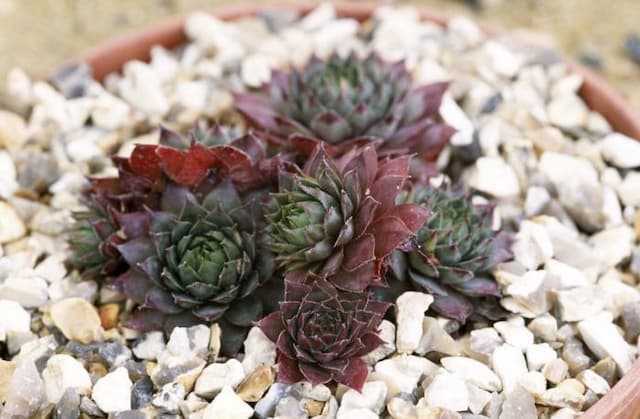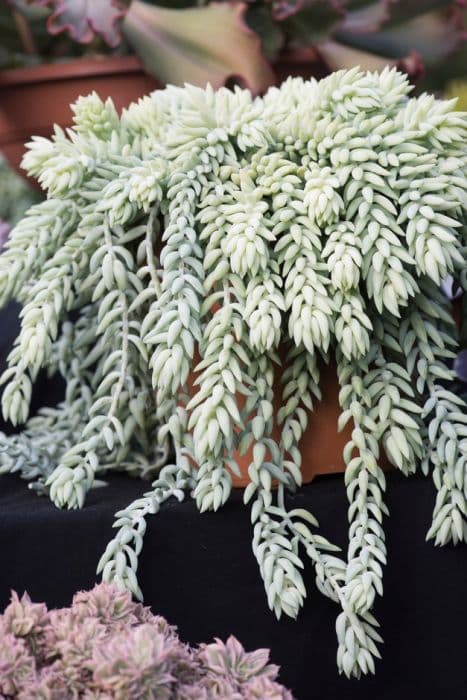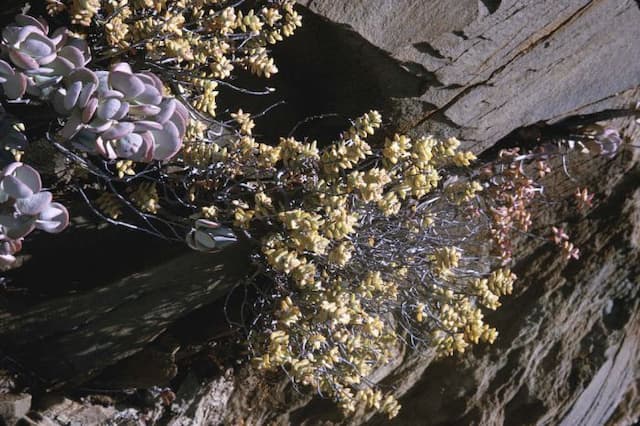Dragon's Blood Stonecrop Sedum spurium 'Voodoo'

ABOUT
Sedum spurium 'Voodoo', commonly known as the 'Voodoo' stonecrop, is a robust, ground-covering plant known for its decorative qualities. It showcases a dense mat of small, scalloped leaves which take on a rich, deep red or burgundy hue, especially under full sun exposure or cooler temperatures. The foliage retains its vibrant color throughout the growing season, providing an eye-catching display of year-round interest. During late spring to early summer, the 'Voodoo' stonecrop produces clusters of star-shaped flowers. These blossoms are typically a bright pink hue, contrasting stunningly against the dark foliage. The flower clusters rise slightly above the leaves, creating a layered appearance and an additional pop of color for the garden. This plant's durable and low-growing habit, coupled with its striking coloration, makes it a popular choice for rock gardens, borders, and as a carpeting plant over sunny areas.
About this plant
 Names
NamesFamily
Crassulaceae
Synonyms
Two-row Stonecrop, Caucasian Stonecrop, Dragon's Blood Stonecrop, Voodoo Stonecrop
Common names
Sedum spurium 'Voodoo'.
 Toxicity
ToxicityTo humans
The plant commonly known as Voodoo stonecrop is not considered to be toxic to humans. However, it should still be handled with care as individual sensitivities can cause mild irritation. Ingesting parts of the plant is not advisable, but it does not typically result in serious poisoning or severe symptoms.
To pets
Voodoo stonecrop is generally considered non-toxic to pets such as cats and dogs. Ingesting the plant should not cause any severe symptoms or lead to significant health issues. However, it is always best to monitor pets if they consume plants and to prevent them from eating large quantities of any non-food plants, as individual reactions can vary.
 Characteristics
CharacteristicsLife cycle
Perennials
Foliage type
Evergreen
Color of leaves
Red
Flower color
Pink
Height
6 inches (15 cm)
Spread
18 inches (45 cm)
Plant type
Succulent
Hardiness zones
3
Native area
Caucasus
Benefits
 General Benefits
General Benefits- Low Maintenance: Sedum spurium 'Voodoo', also known as Voodoo Stonecrop, is a drought-tolerant succulent that requires minimal care once established.
- Erosion Control: Its mat-forming growth habit helps prevent soil erosion on slopes and banks.
- Attracts Pollinators: Voodoo Stonecrop flowers attract bees, butterflies, and other pollinating insects, enhancing local biodiversity.
- Ground Cover: The plant spreads quickly, covering bare spots in the garden and providing a lush, colorful carpet.
- Drought Resistance: It can thrive in dry conditions, making it an excellent choice for water-wise gardens.
- Winter Interest: The leaves and stems of Sedum spurium 'Voodoo' often take on reddish hues in the fall and winter, providing year-round visual interest.
- Adaptable: It can grow in a variety of soil types, though it prefers well-drained soil, making it versatile in different garden settings.
- Heat Tolerance: Voodoo Stonecrop can tolerate high temperatures and thrives in full sun, making it ideal for hot, sunny areas.
- Edging Plant: Its compact growth makes it suitable for edges of paths and garden borders, adding structure to landscaping designs.
- Resistant to Pests: Generally, it doesn’t have many issues with pests, reducing the need for chemical treatments.
 Medical Properties
Medical PropertiesThis plant is not used for medical purposes.
 Air-purifying Qualities
Air-purifying QualitiesThis plant is not specifically known for air purifying qualities.
 Other Uses
Other Uses- Creative arts and crafts – The colorful leaves of Voodoo stonecrop can be used in dried flower arrangements or pressed flower art thanks to their vibrant colors and interesting textures.
- Bioactive terrariums – Voodoo stonecrop can be planted in terrariums designed for reptiles or amphibians to create a more natural and stimulating environment for the pets.
- Eco-friendly roofs – Due to its drought resistance, Voodoo stonecrop is ideal for green roofing projects, which help to improve insulation and absorb rainwater.
- Photography backdrops – The rich, red foliage of Voodoo stonecrop is often used as a contrasting and textured background for macro and nature photography.
- Ground temperature regulator – When used as a ground cover, this plant helps regulate soil temperature by providing shade and cooling the ground on hot days.
- Soil erosion control – Planting Voodoo stonecrop can help prevent soil erosion on slopes due to its mat-forming growth habit which stabilizes the ground.
- Educational model – The rapid growth and easily observable root structures of Voodoo stonecrop make it a good model for educational purposes in botany classes.
- Garden railway landscapes – The miniature and low-growing nature of Voodoo stonecrop makes it an excellent choice for creating realistic miniature landscapes around garden railway setups.
- Living mulch – Its dense foliage can act as a living mulch in garden beds, helping retain soil moisture and suppress weeds.
- Fairy gardens – Voodoo stonecrop's small and colorful appeal makes it a charming addition to whimsical fairy gardens or other miniature gardening projects.
Interesting Facts
 Feng Shui
Feng ShuiThe Voodoo sedum is not used in Feng Shui practice.
 Zodiac Sign Compitability
Zodiac Sign CompitabilityThe Voodoo sedum is not used in astrology practice.
 Plant Symbolism
Plant Symbolism- Resilience: The 'Voodoo' sedum is known for its ability to withstand harsh conditions, representing the human quality of bouncing back and thriving despite adversity.
- Persistence: This plant's capacity to spread and cover ground is a symbol of persistence and the ability to grow and progress steadily over time.
- Protection: Often used in rock gardens and borders, it symbolizes the idea of guarding and defining space, much like setting personal boundaries.
- Adaptability: With its succulent leaves, 'Voodoo' sedum adapts well to various climates, representing flexibility and the willingness to adapt to changing environments.
 Water
WaterDragon's Blood Sedum prefers to be watered deeply but infrequently to mimic natural conditions. During the growing season, it should be watered approximately every 7 to 10 days, depending on the climate and weather conditions, with enough water to moisten the soil around its roots without leaving it soggy. A good rule of thumb is to provide about half a gallon of water per plant during each watering session. In winter, reduce watering to once a month or less, as the plant is dormant and requires less moisture.
 Light
LightDragon's Blood Sedum thrives best in full sun to partial shade conditions. It should be planted in a spot where it can receive at least 6 hours of direct sunlight each day. This succulent can tolerate some shade, especially during the hottest part of the day, but too much shade can lead to poor growth and fewer blooms.
 Temperature
TemperatureDragon's Blood Sedum is a hardy plant that can survive in a wide range of temperatures, from as low as 20 degrees Fahrenheit up to around 90 degrees Fahrenheit. Ideal growing temperatures for this plant are between 65 and 75 degrees Fahrenheit during the daytime and slightly cooler at night. It is cold hardy and can tolerate frost without significant damage.
 Pruning
PruningDragon's Blood Sedum should be pruned to maintain its shape and remove any dead or damaged foliage. This succulent benefits from a light trimming in early spring to encourage bushier growth and more flowers. Pruning is typically done on an as-needed basis rather than on a strict schedule. The best time for pruning is right before new growth starts, usually in late winter or early spring.
 Cleaning
CleaningNot needed
 Soil
SoilDragon's Blood Sedum requires well-draining soil with a pH between 6.0 and 7.5. The best soil mix consists of garden soil, coarse sand, and compost in equal parts to ensure drainage and fertility.
 Repotting
RepottingDragon's Blood Sedum should be repotted every 2-3 years to refresh the soil and provide room for growth. It's seldom necessary due to its hardy and spreading nature.
 Humidity & Misting
Humidity & MistingDragon's Blood Sedum prefers a dry, low-humidity environment, similar to its native rocky and arid habitats.
 Suitable locations
Suitable locationsIndoor
Place in bright light, minimal water.
Outdoor
Full sun, well-drained soil, drought-tolerant.
Hardiness zone
3-9 USDA
 Life cycle
Life cycleThe life of the 'Voodoo' Stonecrop begins with seed germination, which occurs in warm, moist soil conditions, typically in spring. Following germination, the seedling stage is characterized by the emergence of the first roots and shoots as the plant establishes itself. As it enters the vegetative stage, 'Voodoo' Stonecrop spreads out with succulent leaves and stems, forming a mat-like groundcover, thriving in full to partial sun and well-draining soil. During its reproductive stage in summer, it produces clusters of star-shaped, reddish flowers that attract pollinators. After pollination, seeds develop which will disperse, completing the reproductive cycle. 'Voodoo' Stonecrop is a perennial plant, so after the flowering period, it will enter a phase of dormancy during colder months, only to return with new growth the following spring.
 Propogation
PropogationPropogation time
Spring to Summer
The most popular method of propagation for Sedum spurium 'Voodoo', commonly known as 'Voodoo' Stonecrop, is through stem cuttings. This typically takes place in spring or early summer. You can simply take a healthy stem that is about 2 to 4 inches long, remove the lower leaves to expose a bare stem, and then allow the cutting to callous over for a few days. Once the cut end is slightly hardened, insert the stem cutting into a well-draining soil mix, making sure at least one node is buried where leaves were removed. Keep the soil evenly moist but not waterlogged, and in a few weeks, the cutting should root, eventually growing into a new plant. This method is efficient and maintains the genetic fidelity of the 'Voodoo' Stonecrop.









